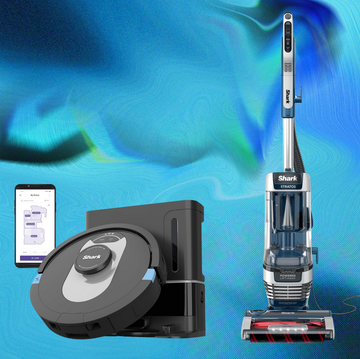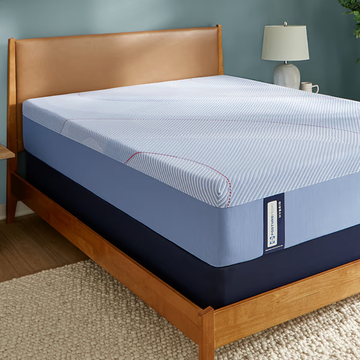Through 25 years of window air conditioner testing, most of the units I've reviewed have stuck to the same basic, industrial-looking design. Windmill, a relative newcomer to the market, and a brand that’s been popping up more and more in my feed, is putting the “cool” in home cooling, which makes sense since window ACs are often a focal point of the room.
The Windmill AC has been dubbed the “iPhone of air conditioners,” thanks to its minimalist, Apple-inspired design, complete with rounded edges and metal-mesh accents. But does it work?
To answer that question, our experts in the Home Improvement & Outdoor Lab at the Good Housekeeping Institute have been testing the Windmill (along with scores of other units) for more than 18 months. Based on our extensive evaluation, I can confirm that the Windmill AC is not only the prettiest window AC on the market, but it’s also one of the best.
Pros and cons of the Windmill AC
PROS:
- Sleek, minimal design with replacement panels that can add a touch of color
- Accurate temperature control and quiet operation
- More energy-efficient than comparable models
CONS:
- On the steeper end of the price spectrum
- Not powerful enough to cool very large spaces
What's special about the Windmill AC?
Since we’re talking looks, let’s start there. Most window ACs made in the last 50 years have two distinct features — a horizontal grate that blows cool air into the room and a front-facing control panel, either with manual knobs or a digital display. By moving both the grate and control panel to the top of the unit, the Windmill has a far less cluttered design.
Meanwhile, its magnetic, mesh-front panel is a chic alternative to the usual plastic grille. For even more style points, the panel comes in standard white or a range of pastel hues. The Windmill also features cosmetic panels with integrated end caps that conceal its accordion-style side panels for a cleaner, sleeker look. Finally, the LED display dims automatically after a few seconds.
The design of the Windmill AC isn’t the only thing that’s less noisy. It’s also one of the quietest ACs from our tests, making it an ideal choice for bedrooms or TV rooms. The quiet operation is a factor of the Windmill’s inverter technology, which replaces the compressor used on standard ACs. Whereas compressors basically run all the time, the Windmill’s inverter sends power to the AC in controlled increments. Besides reducing noise, this engineering improves temperature control and energy efficiency.
All that design and innovation comes at a cost, with the Windmill priced higher than many comparable units. For example, the best value pick in our roundup of top window ACs, an 8,000-BTU Frigidaire, sells for about half as much as the Windmill.
How does the Windmill AC perform?
The Windmill earned near-perfect marks for cooling performance with our trio of expert testers who evaluated the AC over the course of two summers. Consistent temperature control was a top benefit. “My old AC wouldn't circulate the air well, so in some parts of my room, it would be freezing and in others it would still be hot,” one tester explained. Our experts credit the Windmill's airflow design, with air blowing from the top of the unit at a 45° angle, with this superb cooling power. “This AC circulates the air perfectly, so it's the same temperature in every corner,” added the tester.
The Windmill was also very easy to install, thanks to the built-in frame that makes it a cinch to attach the unit securely to your window. “So simple!” said one tester. “It took about 15 minutes to get everything situated securely in the window.”
Another praise-worthy feature of this window AC is its Wi-Fi connectivity, which allows you to control it via the smartphone app or by voice commands through your Alexa or Google Assistant smart speaker.
How big is the Windmill AC?
The Windmill AC comes in four sizes measured in BTUs (British Thermal Units), which correspond to the square footage of a room. Even larger Windmill ACs have a smaller housing than most comparable ACs, so they’re more likely to fit in your window opening.
- 6,000-BTU model is suited to rooms 100 to 200 square feet.
- 8,000-BTU model can cool rooms 200 to 400 square feet.
- 10,000-BTU model is best for areas between 400 and 600 square feet.
- 12,000-BTU unit is best for areas greater than 600 square feet.
If the area you need to cool is larger than that, you're better off with a more powerful window AC from another brand. (Our experts tend to like Friedrich for extra-large cooling needs.)
How we tested the Windmill AC
As with all home comfort equipment, from air purifiers to dehumidifiers, testing of the Windmill AC took place in the Home Improvement & Outdoor Lab, as well as in the homes of consumer testers, enabling us to evaluate the machine in real-world conditions.
Testing focused on the following factors:
✔️ Cooling power: Our experts measured how quickly the Windmill was able to cool a space and how consistently it maintained target temperatures using built-in sensors.
✔️ Ease of use: We graded how easy it was to install and set up the Windmill, how it fit in various windows and how easy it was to remove, clean and re-insert the filter. We also considered enhanced features, including any Wi-Fi capabilities.
✔️ Noise: Engineers in the Lab used a sound meter to determine the loudness at different power levels and fan speeds, and an anemometer to determine the speed and power of each unit's air flow. Home testers evaluated noise in different scenarios, like when they were watching TV and going to sleep.
Bottom line: Is the Windmill AC worth it?
You can’t believe everything you see on your social media feeds. But in the case of the Windmill AC, the hype is real. As one tester told us, “I am seriously obsessed with this AC! It has made such a difference this summer as my room is truly a cool oasis.” Another called the Windmill "the perfect AC for our small living room. It’s so much quieter than our old model, which means we don’t have to blare the volume to watch TV or yell at each other when we have something to say."
Why trust Good Housekeeping?
Dan DiClerico has been testing and writing about air conditioners for more than 25 years. As Director of Home Improvement & Outdoor at the Good Housekeeping Institute, he oversees all window AC testing in our Labs, as well as the continuous in-home, survey-based consumer testing that allows us to evaluate the equipment in real-world conditions. He is also a regular at trade shows and other industry events, where he keeps up with the latest in home cooling.
Having written thousands of product reviews and how-to articles on all aspects of home ownership, from routine maintenance to major renovations, Dan (he/him) brings more than 20 years of industry experience to his role as the director of the Home Improvement & Outdoor Lab at the Good Housekeeping Institute. A one-time roofer and a serial remodeler, Dan can often be found keeping house at his restored Brooklyn brownstone, where he lives with his wife and kids.















